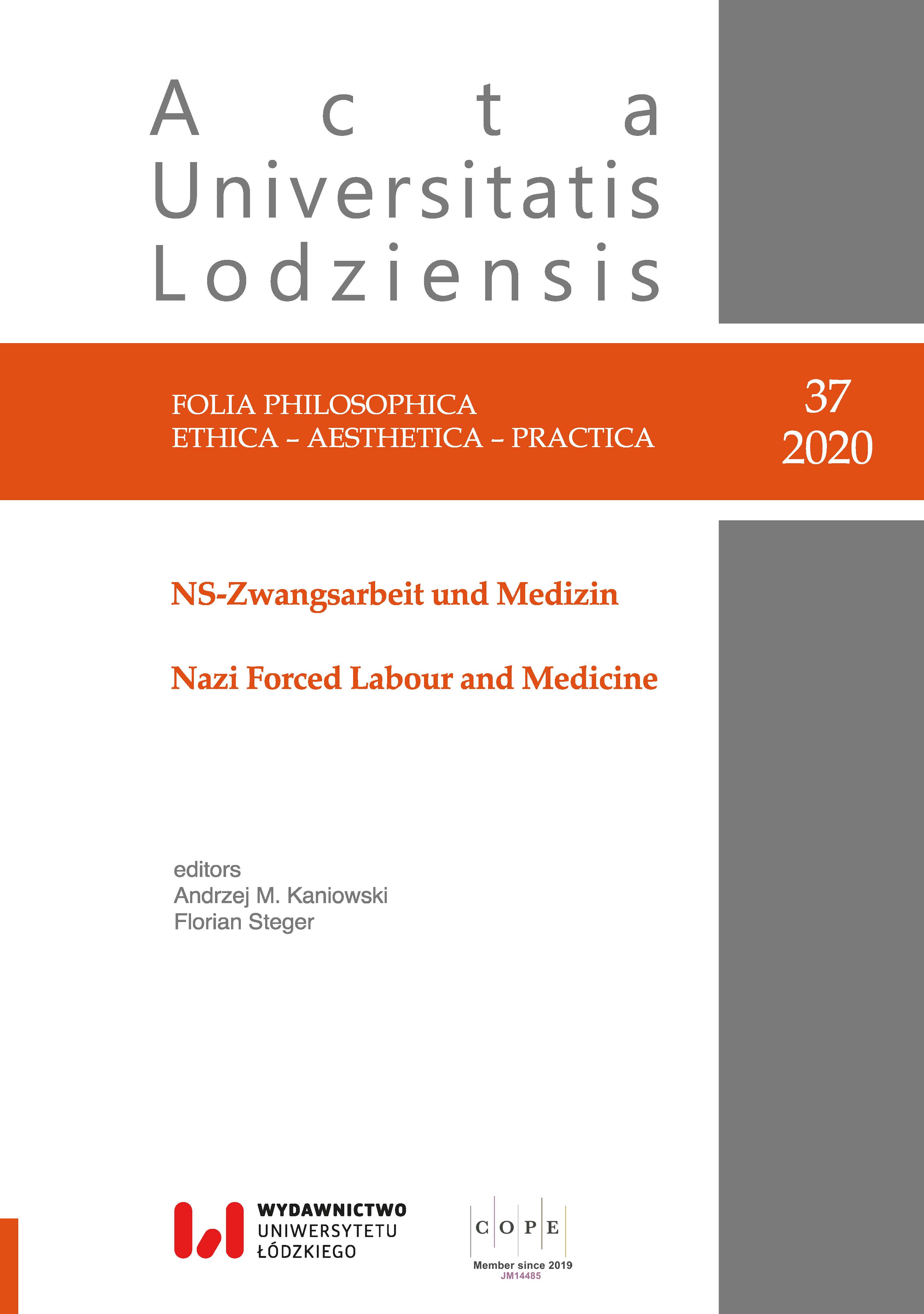Medical Care for Polish Forced Laborers in the Bielefeld Region
DOI:
https://doi.org/10.18778/0208-6107.37.06Keywords:
national socialism, Nazism, forced-labor, Polish forced-laborers, medical careAbstract
Polish and Soviet forced laborers labelled in the Nazi ideology as “Untermenschen” were the worst treated nationalities among those employed by the Third Reich and its war machine. The treatment of Poles and Russians was entirely subordinated to the racial ideology with its profound impact on the law and social and economic conditions. This ideology ordered, on the one hand, the precise separation of Polish and Soviet forced laborers from German citizens, and on the other, the optimal organization of the forced labor which meant its entire subordination to the German state and its industry. The result of such an organization was an entirely repressive, even beastly system, with miserable living conditions and most inferior medical care. Both living conditions and medical treatment show, as in a lens, the main objectives of the Nazi state and its dehumanized character.
Bielefeld Stadt und Land, located in north-east Westphalia, due to its mixed industrial (mostly arms industry) and agricultural character, constitutes a representative example of the brutal and repressive system of the forced labor industry reflecting the entire spectrum of problems related to it. The analysis of medical care in the Bielefeld area illustrates the differences between the two groups of Polish forced laborers. The first consists of people in the industry sector, while the second is a mixed category including workers employed in agriculture, the service sector and domestic help. As far as the first group is concerned, the status of the workers was to some extent standardized. Most of them were accommodated in the camps and subjected to brutal and systematic exploitation, which was calculated to maximize production effects, and at the same time, to destroy individuals through the adverse conditions of accommodation and minimal medical care. This inhumane treatment was a result of racist ideology. Status, employment conditions and medical care in the second group were much more diverse. We are dealing here with the entire spectrum, often of extremely different experiences of forced laborers with medical personnel and the diverse attitudes of the employers. The fundamental problem of the limited research materials on the discussed issues are deficiencies of the source base. In particular this concerns the limited recollections of the forced laborers themselves. Currently, it is virtually impossible to increase the source dossier, as witnesses of these events are mostly no longer available.
References
Anschütz, Janet, Heike Irmtraud. „Medizinische Versorgung von Zwangsarbeitern in Hannover. Forschung und Zeitzeugenberichte zum Gesundheitswesen.“ In Zwangsarbeit und Gesundheitswesen im Zweiten Weltkrieg. Einsatz und Versorgung in Norddeutschland. Hg. von Günter Siedbürger und Andreas Frewer. Hildesheim, Zürich, New York: Olms, 2006.
Google Scholar
Benad, Matthias, Regina Mentner (Hg.). Zwangsverpflichtet. Kriegsgefangene und zivile Zwangsarbeiter(-innen) in Bethel und Lobetal 1939–1945. Bielefeld: Bethel-Verlag, 2002.
Google Scholar
Freitag, Gabriele. Zwangsarbeiter im Lipper Land. Der Einsatz von Arbeitskräften aus Osteuropa in der Landwirtschaft Lippes 1939–1945. Bochum: Verlag Dr. Dieter Winkler, 1996.
Google Scholar
Gastwirtschaft „Vadder Ertel“ in Schildesche – Arbeitskommando des Stalag VI A. Dokumentation der Erinnerungen von Zwangsarbeiter(-innen) – Kriegsgefangenen an Bielefeld 1939–1945. Eine Dokumentation der Klasse 10a der Martin-Niemöller-Gesamtschule Bielefeld. Bielefeld: Oberstufen-Kolleg, 1998.
Google Scholar
Herrenmenschen – Untermenschen. Erinnerungen ehemaliger polnischer und ukrainischer Zwangsarbeiterinnen und Zwangsarbeiter an ihre Zwangsarbeit im Raum Bielefeld 1939 bis 1945. Projektbericht des Wahlfachkurses Soziologie am Oberstufen-Kolleg der Universität Bielefeld. Redaktion: Hans-Georg Pütz. Bielefeld, Juni, 2001 (die Aussagen der Zwangsarbeiter entstammen der Interviewsammlung des Kursleiters des Wahlfachkurses Soziologie, Hans-Georg Pütz, die dem Autor zur Verfügung gestellt wurde).
Google Scholar
Herbert, Urlich. Fremdarbeiter. Politik und Praxis des „Ausländer-Einsatzes“ in der Kriegswirtschaft des Dritten Reiches. Bonn: Dietz, 1999.
Google Scholar
Hodorowicz-Knabb, Sophie. Naznaczone literą „P”. Polki jako robotnice przymusowe w III Rzeszy 1939–1945. Kraków: Wydawnictwo Literackie, 2018.
Google Scholar
Hrabar, Roman. Skazane na zagładę. Praca niewolnicza polskich kobiet w III Rzeszy i los ich dzieci. Katowice: Wydawnictwo Śląsk, 1989.
Google Scholar
Kettermann, Günter. Kleine Geschichte der Bielefelder Wirtschaft vornehmlich im 19. und 20. Jahrhundert. Bielefeld: Pfeffersche Buchhandlung, 1985.
Google Scholar
Kühne, Hans Jörg. Kriegsbeute Arbeit. Der „Fremdarbeitereinsatz“ in der Bielefelder Wirtschaft 1939–1945. Bielefeld: Verlag für Regionalgeschichte, 2002.
Google Scholar
Kwieciński, Wojciech. Polscy robotnicy przymusowi w regionie bielefeldzkim podczas drugiej wojny światowej (1939–1945). Rzeszów: Wydawnictwo Uniwersytetu Rzeszowskiego, 2014.
Google Scholar
Lechner, Silvester (Hg.) Schönes, schreckliches Ulm. 130 Berichte ehemaliger polnischer Zwangsarbeiter die in den Jahren 1940 bis 1945 in die Region Ulm/Neu Ulm verschleppt worden waren. Ulm: Dokumentationszentrum Oberer Kuhberg Ulm e.V., KZ-Gedenkstätte 1996.
Google Scholar
Łuczak, Czesław. Polscy robotnicy przymusowi w Trzeciej Rzeszy podczas II wojny światowej. Poznań: Wydawnictwo Poznańskie, 1974.
Google Scholar
Rusiński, Władysław. Położenie robotników polskich w czasie wojny 1939–1945 na terenie Rzeszy i „obszarów wcielonych”. Band II. Poznań: Instytut Zachodni, 1955.
Google Scholar
Schwarze, Gisela. Kinder, die nicht zählten – Ostarbeiterinnen und ihre Kinder im Zweiten Weltkrieg. Essen: Klartext, 1997.
Google Scholar
Siegfried, Klaus-Jörg. Das Leben der Zwangsarbeiter im Volkswagenwerk 1939–1945. Frankfurt am Main, New York: Campus, 1988.
Google Scholar
Spoerer, Mark. Praca przymusowa pod znakiem swastyki. Cudzoziemscy robotnicy, jeńcy wojenni i więźniowie w Niemczech i okupowanej Europie w latach 1939–1945. Gdańsk: Muzeum II Wojny Światowej w Gdańsku, 2015.
Google Scholar
Stefanski, Valentina Maria. Zwangsarbeit in Leverkusen: polnische Jugendliche im I.G. Farbenwerk. Osnabrück: Fibre, 2000.
Google Scholar
Szurgacz, Herbert. Przymusowe zatrudnienie Polaków przez hitlerowskiego okupanta w latach 1939–1945. Wrocław, Warszawa, Kraków, Gdańsk: Ossolineum, 1971.
Google Scholar
Witt, Jan. Vom Saisonarbeiter zum Zwangsarbeiter. Voraussetzungen und Etablierung des „Ausländereinsatzes“ im Raum Minden 1939–1942. Magisterarbeit Universität Bielefeld 2000.
Google Scholar
Downloads
Published
How to Cite
Issue
Section
License

This work is licensed under a Creative Commons Attribution-NonCommercial-NoDerivatives 4.0 International License.












